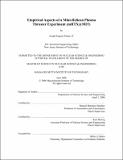Empirical aspects of a Mini-Helicon Plasma Thruster Experiment (mHTX@MIT)
Author(s)
Palaia, Joseph Eugene, 1979-
DownloadFull printable version (17.22Mb)
Alternative title
mHTX@MIT
Other Contributors
Massachusetts Institute of Technology. Dept. of Nuclear Science and Engineering.
Advisor
Manuel Martinez-Sanchez and Kim Molvig.
Terms of use
Metadata
Show full item recordAbstract
A helicon plasma source experiment has been developed and then constructed in the MIT Space Propulsion Laboratory (SPL) vacuum chamber. This experiment allows study of the intrinsic advantages of efficient helicon plasma production for use in space electric propulsion. Historical helicon experiment data have been applied to help size the experiment. The goal was to create a robust and flexible experimental system which would allow optimization of the source and system parameters for efficient thrust generation, and would permit for correlation between helicon theory and experiment. This effort may lead to the development of a new electric propulsion device, the Mini-Helicon Plasma Thruster. A design process was undertaken for the creation of this experimental setup, with the aid of a number of students and researchers at the MIT SPL. This thesis will focus on the author's specific contributions to this larger effort, which included the following elements. A survey of past helicon experiment parameters was completed, made possible largely due to the wealth of data provided by helicon plasma use in academia and for research and development. An analysis of the flow of propellant through the thruster was completed, utilizing low Mach number flow theory. A metallic structure was designed, structurally analyzed and constructed to support the electromagnets used to provide the required magnetic field. In addition, a radio frequency matching network enclosure and suitable interconnections were designed and constructed as part of the RF power delivery system. The result of the design and construction effort is a working, reliable, and flexible helicon plasma source system. This system provides the capability for future experimentation and helicon plasma thruster development.
Description
Thesis (S.M.)--Massachusetts Institute of Technology, Dept. of Nuclear Science and Engineering, 2006. This electronic version was submitted by the student author. The certified thesis is available in the Institute Archives and Special Collections. Vita. Includes bibliographical references (leaves 115-117).
Date issued
2006Department
Massachusetts Institute of Technology. Department of Nuclear Science and EngineeringPublisher
Massachusetts Institute of Technology
Keywords
Nuclear Science and Engineering.